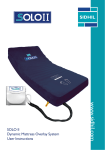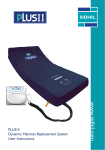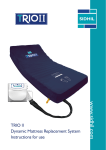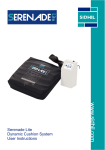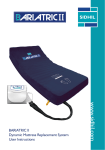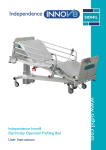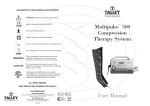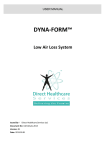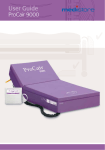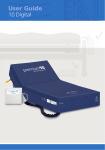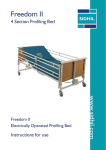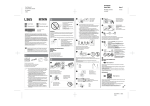Download Solo II User Guide
Transcript
www.sidhil.com SOLO II Dynamic Mattress Overlay System Instructions for use CONTENTS Important Notice Before operating this medical equipment, it is important to read these instructions for use and understand the operating instructions and safety precautions. Failure to do so could result in injury and/or damage to the product. If you have any questions, please see the contact information on the rear cover. INTRODUCTION........................ 4 SAFETY PRECAUTIONS............. 5 PRODUCT OVERVIEW................ 6 INSTALLATION........................... 7 OPERATION................................ 9 Control Unit Panel....................... 9 Mattress Function....................... 10 Use of Incontinence Products..... 11 Static Mode................................ 11 Removal & Transport Function.... 12 Mains Supply Power Failure ....... 12 TROUBLESHOOTING............... 13 CLEANING................................. 15 MAINTENANCE........................ 16 TECHNICAL SPECIFICATION..... 17 WARRANTY INFORMATION.... 23 3 INTRODUCTION Solo II Dynamic Mattress Overlay System Thank you for choosing a Solo II Dynamic Mattress Overlay System. These instructions for use should be read carefully before using the mattress as it contains important information regarding the safe operation and maintenance of the product in order to provide long lasting and reliable service. Please ensure that you understand all the instructions, if you have any questions concerning the operation and maintenance of the mattress please contact your supplier who will provide you with expert professional advice. A. Solo II Mattress System The box contains an assembled mattress system consisting of: A. Solo II Alternating Dynamic System B. Digital Control Unit C. Power Cord B. D. Carry Bag E. Instructions for use C. D. E. 4 SAFETY PRECAUTIONS In General Warning • Do not use this equipment in the presence of flammable anaesthetics or in oxygen rich environments. • Keep away from sources of heat and naked flames. • Occupants and users of this equipment must never smoke in close proximity to the control unit, mattress or bedding being used with it - Risk of fire. • Bed frames used with the systems can vary greatly depending on the specific healthcare setting (i.e. hospitals, nursing homes, home care etc). It is the responsibility of the carer to carry out the necessary risk assessments to ensure the safety of the patient. This includes, but is not limited to, the appropriate use of side rails to prevent falls and/or patient entrapment. • Minimise articles (e.g. bedding) between the mattress surface and patient, and secure bed sheets loosely so as not to affect the alternating cell movement. • When in normal use the mattress control unit must be connected to an appropriate power source at all times. • Children and pets are to be kept away from the mattress system at all times. • The mattress system must be installed and operated in accordance with the details in these instructions for use. Control Unit Warning • The control unit is tested and CE marked in line with Medical Device Directive (93/42/EEC). • Only plug into a mains socket using the mains cable supplied with the system. • Exposure of the control unit to any liquid while it is plugged in could result in a severe electrical hazard. • Only use fuses that have the same specified rating. Using fuses with higher ratings could result in damage and/or injury. (See Technical Specification on page17). • The control unit is a precision electronic product. Use care when handling or transporting it. Dropping or other sudden impacts may result in damage to the unit. • Do not open the control unit – risk of electrical shock. Do not attempt to repair or service the control unit. Repairs and service should be conducted by suitably trained personnel. If the control unit is not functioning properly, or has been damaged, unplug the unit and take it out of service immediately (see the contact information on the rear cover for repair and service information). • Do not place any objects or items, such as blankets, on or over the control unit. • The mains cable to the control unit should be correctly positioned to avoid a tripping hazard and/or damage to the cable. It is recommended to place the cable under the bed frame and attach it to a mains socket by the head end of the bed. • No modification of the control unit or mattress is allowed without the permission of Sidhil Ltd. • The RF emissions from the mattress control unit are very low and are not likely to cause any interference to nearby electronic equipment, however interference to sensitive equipment is possible. 5 PRODUCT OVERVIEW Alternating Mattress System (see Technical Specification page 17) Control Unit The Solo II Dynamic Mattress Overlay System is intended to provide comfort and pressure relief The control unit provides the air supply to the to patients vulnerable to pressure damage. It is mattress. designed for use on both standard and profiling bed frames. Ideally, patients allocated to this • It is controlled via a touch panel with integrated system will have some degree of independent digital display. The alarm sounds when low mobility or can be repositioned according to pressure is detected or when power is individual needs. interrupted. The alarm mute function silences the alarm for a maximum of 20 minutes – the For assistance in setting up, using or maintaining alarm resumes if the cause of failure is not this mattress system or to report unexpected resolved. The alarm will sound for up to two operation refer to the contact details found on the hours following an interruption to power. back of this booklet or at www.sidhil.com or via • The control unit includes a back up battery for your local distributor. The maximum patient weight limit is 177kgs (28 stone). the audible alarm. This battery is continuously re-charged and will last the life time of the product. • Functions on the control panel adjust the 8 Mattress comfort level settings. This system includes three static head cells to • When a fault condition exists a warning LED is provide static support for optimum user comfort, illuminated with an audible alarm. while air pressure in the other cells is alternated over a 12 minute cycle. This provides regular The visible and audible alarm function has a periods of pressure reduction to aid blood and number of indications depending on the cause of the failure (see’Troubleshooting’ section on page 13). lymphatic flow to vulnerable tissue. 6 If the mains cable becomes detached the alternation sequence is suspended and the mattress cells remain inflated and/or deflated based on the current cycle. The audible alarm will sound INSTALLATION Any damaged or missing components should be reported to your supplier as soon as possible. System Installation Control Unit Activation a.Position the control unit by hanging the hooks The following describes the procedures for the over the foot board or place the unit on the initial system set up: floor under the bed with the front facing a.Remove all covers, sheets and mattress from upwards. Ensure the rear of the unit is not the bed. obstructed by carpet, rugs etc. It is advisable to place the unit on a firm surface. b.On a standard bed, position the mattress b.Attach the air connector handle to the control on top of the bed frame, top cover facing unit. Ensure air hoses do not kink between upwards and air hoses at the foot of the bed frame and control unit. for control unit positioning. c.Attach to the bed frame by securing the adjustable straps loosely under each section of the bed. c.Insert mains cable into the control unit, plug into a mains socket. d. Press the power button for at least two seconds to activate the control unit. The pressure LED’s will flash indicating the system Do not secure mattress straps to has activated. The system will be ready for use in bed side rails as straps will tear. a maximum of 50 minutes. d.To avoid any risk of damage to the mattress e.When initial inflation is complete, the 4th ensure there are no sharp objects which may pressure LED and the alternating mode LED come in contact with it. will illuminate to indicate the system is ready Check that the attachment of the mattress does not interfere with the movement or operation of the bed. for use (system automatically defaults to alternating mode at start-up). f.Once inflated, ensure the straps that attach the mattress to the bed frame are secure and hold the mattress in place, adjust as necessary. e.Ensure the CPR tag sealing connectors are g.Once the mattress is fully inflated, the bedding pushed firmly onto the air pipes. can be replaced. Secure sheets loosely enough to ensure they do not interfere with cell alternation. 7 INSTALLATION To attach the handle to the control unit 1) Depress the lever on the top of the handle. 1 2) Aligning the ports on the handle with those on the control box, firmly push the handle into position. 2 3) Release the lever, ensuring this has engaged onto the catch connected to the control box. To remove the handle to the control 1) Depress the lever on the top of the handle. 2) Pull the handle away from the control unit. Warning • Avoid placing the mattress system in direct sunlight. • Avoid placing the mattress system in a moisture rich environment. • Keep away from sources of heat and naked flames (e.g. fireplaces, electric fires, fan heaters etc). • Consideration is to be taken in the positioning of the mains cable and air hose to minimise the risk of accidental strangulation resulting from baby or child entanglement – if clipping/routing points are available on the bed frame it is recommended that these are used. • It can be unsafe to use accessories not approved by Sidhil Ltd. in conjunction with this mattress system, if in doubt contact Sidhil Ltd. or your local distributor. • Wireless communications equipment such as wireless home network devices, mobile phones, cordless telephones including their base stations and walkie-talkies could all affect the operation of the mattress system and should be kept a minimum distance away. If the mattress system or any alternative equipment is found to be operating abnormally mitigation measures should be taken, such as the separation distances being increased and/or the products being re-orientated - see page 22 for separation distance detail. (Example: for a typical mobile phone with a maximum output power of 2W it yields a separation distance of 3.3m from the control unit). 8 OPERATION Control Unit Panel A. Power Button setting. There are 8 available pressure settings Turns system on/off by pressing for at least 2 from soft to firm (18mmHg to 60mmHg; 6mmHg seconds. per step). The green LED’s illuminate to indicate B. Alarm LED which of the 8 settings is operational. The red LED flashes and an audible alarm sounds F. Max Button when a fault condition has arisen in the control Pressing the ‘max’ button facilitates rapid inflation unit or mattress. to the maximum pressure setting (60mmHg), C. Alarm Mute Button the orange ‘static’ LED will illuminate. After 20 Silences the audible alarm. The audible alarm will minutes, the system automatically reverts back to resume after 20 minutes if the cause of failure is the previous pressure setting for patient safety. unresolved. If this function requires cancellation prior to The audible alarm also sounds when the power is the system automatically switching back to the switched off – press alarm mute to silence. previous setting either the ‘max’ or ‘A/S’ buttons D. A/S Button can be pressed. Selecting alternating mode cyclically inflates and G. Control Unit Lock / Unlock Button deflates the cells in sequence. Pressing for at least 2 seconds locks the control unit settings – an audible tone sounds and an Selecting static mode fully inflates all cells with no amber LED illuminates to indicate the system is dynamic alternation. locked. When locked, only the alarm mute and Static mode will automatically revert to lock / unlock buttons remain operational. alternation mode after 1 hour for patient safety. Pressing again for at least 2 seconds unlocks E. Pressure ‘+/-’ Buttons the control unit (alarm sounds and amber LED Press ‘+/-’ to increase or decrease the pressure extinguishes). Warning • The control unit will automatically unlock in the event of a power failure. • It is recommended that after the system becomes fully operational that the lock is applied to reduce the risk of accidental or intentional tampering by children, adults with learning difficulties, pets etc. D C G E B 9 F A OPERATION Mattress Function Establishing Pressure (supine patient) Establishing Pressure (upright position) With the patient lying supine (face upwards), use When moving the patient to a sitting or more the ‘+/-’ functions to establish the best setting for upright position, the pressure may need to be effective support and comfort. increased to provide added support and to avoid Before changing or lowering the pressure, ensure bottoming out. • It is important to return to the the system is working effectively by performing a original pressure setting when ‘bottoming out’ test. the patient returns to the supine Once the system has been set for the patient, position. re-check it after approximately 20-30 minutes to • Wait a minimum of 12 minutes ensure the patient is comfortable and that the unit between pressure adjustment is functioning correctly. and patient assessment, it may Bottoming Out Test take a full cycle for the system to When altering the pressure setting, ensure adjust. the patient is not bottoming out (insufficiently supported by the air cells). CPR Function Rapid deflation of the mattress may be required 1. Ensure the system is in alternation mode. for emergency treatment or system deflation. 2. With the patient lying in a supine position, Firmly pull the release CPR tag from the side of the unzip top cover just past the sacral mattress to rapidly deflate the entire system. (buttocks) region. To re-inflate the system after the CPR tag has 3. A hand should slide easily between the been pulled, replace the CPR tag ensuring all patient and the foam without causing the foam sealing connectors are firmly attached (see image to compress. opposite) and restart the control unit. Wait for the 4. If a hand can pass under the sacral area the patient is adequately supported and pressure can be lowered as required. 5. Repeat bottoming out test if pressure has mattress system to reach optimal pressure. • A bottoming out test must be performed after mattress inflation, following rapid deflation. been lowered. • The re-inflation settings could be different to the settings prior to deflation. Ensure the correct pressure setting is selected. 10 OPERATION To gain access to the sealing connectors, unzip the top cover past the CPR tag. Push together keeping both halves parallel to each other. Use of Incontinence Products Static Mode Incontinence products such as sheets or pads Patients should always be nursed on the mattress can be used with this system. However, product in alternating mode but the static mode maybe performance is likely to reduce due to the patient selected for short intervals if a patient is finding experiencing less pressure relief when using these it difficult to tolerate the alternating mode. (This aids. could occur if, for example, the patient is in pain, If incontinence products are to be used it is nauseated or perhaps having difficulty in getting recommended that regular patient skin checks are off to sleep). performed to ensure skin integrity is maintained. When static is selected all cells inflate at the pressure at which the mattress is set, thereby offering a non moving surface. The digital control system will return to alternating mode after one hour, if not manually selected by the user. This is a safety mechanism to ensure patients are not left on a constantly inflated surface. It should be used only after assessing the risk to the patient’s skin. To select static mode depress the ‘A/S’ button, the static LED will illuminate. The pressure can be adjusted to suit using the pressure adjustment ‘+/-’ functions on the front of the control unit. 11 OPERATION System Removal Transport Function 1. Turn off the control unit by pressing the power 1.Before patient transport, switch modes from button for at least 2 seconds and unplug the alternating to static and wait for 12 minutes mains cable. for all cells to inflate. 2.Remove the air connection handle from the 2.Remove the air connection handle from control unit and disconnect the CPR tag. the control unit, sealing with the attached transport cap (see image below). 3. Place the control unit and mains cable on top of the mattress and detach the mattress from the bed frame. 4.Once air has been released from all cells, roll 3.Turn off the control unit. The mattress will stay inflated under normal conditions for up to 30 hours. up the mattress and return all items to the carry bag for safe keeping. Mains Supply Power Failure If it is known there is to be a power cut in advance, follow the instructions detailed under the heading ‘Transport Function’ prior to the power going off. In the event of an unplanned power cut: C 1. Remove the air connection handle from the control unit and seal with the attached transport cap. 2. Turn off the control unit. The mattress will stay inflated under normal conditions for up to 30 hours. C 12 TROUBLESHOOTING The red alarm LED flashes and an audible alert sounds, to indicate the control unit or mattress pressure has failed. The LED will remain illuminated until the appropriate pressure is restored. The audible alarm can be silenced by pressing the alarm mute button. The system has 5 different alarm signals, identified by 5 different pressure setting illumination sequences. The signals and corresponding pressure setting LED displays are illustrated below: Alarm/FaultCause Solution Control unit does not The control unit 1.Check the mains cable is firmly plugged into a wall operate; no display may not be attached socket and the control unit. Check the mains power is LED’s illuminated to a power socket switched on (to ensure the socket is working plug in a or a fuse may need lamp or other fused electrical device). replacing 2.Check the mains plug fuse (3A) then check control unit fuse (1A) – see Section ‘Maintenance’ on page 16. Do not try to open the control unit. Opening the unit could cause personal injury or equipment damage. Alarm LED Initial failure 1. Reset the alarm – turn off power and press the (within 50 minutes) alarm mute button. 2. Check the handle is intact, ensuring all four sealing + audible alarm connectors are firmly fitted to the control unit and the air hoses. Check the CPR tag is attached and all sealing connectors are firmly secured. 3. Check all air hoses along the inside of the mattress – each should be firmly connected. Check each air cell is securely attached to its connecting air pipe. 4. Check all cells, pipes and hoses for any air leakage. 5. Switch on power. Alarm LED + audible alarm Pressure too low 1. Reset the alarm – turn off power and press the alarm mute button. 2. Check the handle is intact, ensuring all four sealing connectors are firmly fitted to the control unit and the air hoses. Check the CPR tag is attached and both sealing connectors are firmly secured. 3. Check all air hoses along the inside of the mattress – each should be firmly connected. Check each air cell is securely attached to its connecting air pipe. 4. Check all cells, pipes and hoses for any air leakage. 5. Switch on power. 13 TROUBLESHOOTING Alarm/FaultCause Solution Alarm LED 1.Reset the alarm – turn off power and press the alarm Pressure too high mute button. 2.Disconnect the air hoses to reduce pressure – + audible alarm reconnect when the pressure has decreased. 3.Check for twists in the air hoses between the mattress and control unit. 4.Switch on power. Alarm LED Alternating 1.Reset the alarm – turn off power and press the alarm mode failure (no + audible alarm alternation) mute button. 2.Disconnect the air hoses to reduce pressure – reconnect when pressure has decreased. 3.Switch on power. Alarm LED Power down 1.Press the alarm mute button to silence the audible alarm. 2.Check the mains cable is firmly plugged into a wall socket and the control unit. Check the mains power + audible alarm is switched on (to ensure socket is working plug in a lamp or other fused electrical device). 3. Check the mains plug fuse (3A) then check the control unit fuse (1A) – see section ‘Maintenance’ on page 16. Patient is sinking or The pressure may bottoming out be set too low for the patient’s Do not try to open the control unit. Opening the unit could cause personal injury or equipment damage. 1.Increase the pressure setting by pressing the ‘+’ button. 2.To check effective system performance, conduct a weight bottoming out test as described previously. If the above actions fail to rectify the problem please see page 16. 14 CLEANING Infection Control This is achieved by unzipping the top cover and Routine cleaning for infection control must be looking for signs of staining to the white underside. carried out in accordance with your local infection Any evidence of strike-through will require a new control policy or regulatory body. cover to be fitted to the system. The cover must not be reused if strike- of the mattress system will help through is evident. to prevent the risk of infection to Wipe down with a disposable soft cloth moistened the occupant. with a mild detergent and diluted in warm water • Regular cleaning and disinfection (40˚C), dry thoroughly before use. Wipe down • Prior to transferring the mattress system to another user with a solution of Sodium Hypochlorite or similar ensure it has been cleaned and (up to 1,000ppm Chlorine), dry thoroughly before disinfected using the method as use. stated below. In extreme cases 10,000ppm Chlorine can be used but the following process must be adhered to: 1) Wipe cover down using cold water 2) Clean with Chlorine solution 3) Finally wipe cover again using cold water. Cleaning the Control Unit • Disconnect the mains cable from the power socket before attempting to clean the control unit. The top cover may also be decontaminated using • Do not immerse the power unit Ethylene Oxide or the Draeger method. in water. Additional infection control and routine cleaning • Ensure the mains cable and must be carried out in accordance with your local power unit are dry before use. infection control policy. The control unit can be cleaned by wiping down Do not use Phenol based cleaning agents (e.g. with a damp cloth soaked in a sodium hypochlorite Stericol, Hycoline, Clearsol etc.). solution (1000 ppm available chlorine) and dried Mattress Cover Cleaning Instructions with a clean dry cloth. 71 C The power unit is not IP rated therefore care should be taken to ensure only a damp cloth is use. Do Not Iron Do Not Bleach Cleaning the Mattress Before attempting to clean the mattress the top cover should be checked for physical signs of Do Not Dry Clean Tumbe Dry on Low Heat damage that may lead to strike-through (ingress of fluid through cover). Machine Wash at 71°C If the above washing instructions are not 15 followed the warranty will be invalidated. MAINTENANCE Only authorised service personnel or Sidhil service engineers should carry out repairs or service activities. For Service & Support outside of the UK & Northern Ireland please contact the local distribution company from where this equipment was purchased. Failure to do so may result in the product warranty becoming void. The mattress system must be serviced once yearly, as a minimum. Sidhil also recommends that the carer performs frequent visual and operational inspections. If there are any signs of damage or the system is not performing as it should withdraw it from service until the system has been repaired and is fit for use again. Sidhil Ltd recommend that the following maintenance procedure is performed every 12 months. • • • • • • • Check that all electrical functions operate correctly on the control unit. Check the CPR connection on the mattress. Check for signs of strikethrough on the top cover. Check that all piping and cells within the mattress are in good condition. Check that all electrical cables are in good condition. Check the control unit housing is not cracked or damaged. Check that the mains cable and plug are in good condition, if either is damaged it must be replaced with a complete assembly, the plug must never be rewired. For more detailed service information, spare parts, circuit diagrams etc. please refer to the service manual. Copies are available from Sidhil Ltd. Contact details can be found on the back of this booklet or at www.sidhil.com Disposal of components must comply with local policy. For the control unit follow the local W.E.E.E recycling policy, do not discard in general waste. For additional assistance with disposal refer to the contact details found on the back of this booklet, at www.sidhil.com or via your local distributor. • • If any maintenance is performed, the control unit must always be switched off at the wall first. Prior to and after performing any maintenance ensure the mattress system has been cleaned and disinfected. Air Filter Replacement See service manual for control unit air filter maintenance and replacement. Good filter maintenance is critical to maintain an optimal operating system. Failure to keep the filters clean will result in system downtime and increase repair costs. It is recommended that the air filter be replaced annually. Replacement air filters are available; please see contact information on rear cover. Fuse Replacement - Control Unit 1.Switch off the power supply to the control unit. 2.Remove the mains cable from the control unit. 3.Insert a small flat head screwdriver into the groove in the fuse holder, and turn anticlockwise (quarter turn). 4.Remove the used fuse from the fuse holder clip and discard. 5.Insert a new fuse into the fuse holder clip. Push the fuse holder into the control unit against the force of the spring and turn clockwise with the screwdriver (quarter turn). 16 TECHNICAL SPECIFICATION Control System Digital micro controller Cycle Time 12 minutes Supply Voltage 220-240VAC, 50Hz 0.2A for Control Unit Fuse Rating Mains Plug – 3A Control Unit – 1A (x1) Power Rating12VA No. of Cells 18 cells which includes: 3 static head cells 15 alternating cells Cell Height 115mm Alternating therapy AB pattern Maximum patient weight 177kgs (28 stone) Length 2000mm± 20mm Mattress Replacement Width 880mm ± 20mm Dimensions Height 120mm ± 10mm Weight5.0kgs Height 270mm Control Unit Width 290mm Dimensions Depth 120mm Weight3.5kgs Cell material 210D PA/TPU Base material 420D PA/TPU Cover material Biocompatible PU/knitted PES. two-way stretch, 195 g/m² Hose Connection Push on connector handle Emergency CPR Rapid release tag Mode of Operation Non-continuous Transport and storage Ambient temperture -25°C to +70°C Humidity 10% to 93%, non condensing Operation Ambient temperature +5°C to +40°C Relative humidity 15% to 93%, non condensing Atmospheric pressure 700hPa to 1060hPa Operating altitude ≤ 2000m Pollution Degree 2 Classification IEC60601-1 IEC 60601-1-11 Class II equipment IPX0 Not category AP/APG equipment CE marked in line with Medical Devices Directive (93/42/EEC) Applied Parts Mattress - Type BF Expected service life 2 years All product specifications are subject to change without notice. 17 TECHNICAL SPECIFICATION Definition of Symbols Used The following symbols may appear in these instructions for use or on the control unit. Some of the symbols represent standards and compliances associated with the control unit and its use. Warnings in these instructions for use highlight potential hazards that if disregarded could lead to injury or death. Cautions in these instructions for use highlight potential hazards that if disregarded Caution: Consult accompanying document s could lead to equipment damage or failure. Class II II equipment Class equipment Manufacturer Manufacturer Serial Number Serial number Type par t Type B BF applied applied part W.E.E.E Label Do not dispose of this pr DISPOSAL: oduct as unsorted mun of local such waste separately for special t (Do not discard inCollection general waste, follow recycling policy) Refer to instructions for use Authorised representative in the European community Keep Dry No Smoking 18 TECHNICAL SPECIFICATION Declaration – electromagnetic emissions- for all ME EQUIPMENT and ME SYSTEMS Guidance and manufacture’s declaration – electromagnetic emission The Solo II is intended for use in the electromagnetic environment specified below. The customer or the user of the Solo II should ensure that it is used in such an environment. Emission test Compliance Electromagnetic environment – guidance RF emissions Group 1 The Solo II uses RF energy only for its internal function. Therefore, its CISPR 11 RF emissions are very low and are not likely to cause any interference in nearby electronic equipment. RF emission Class B The Solo II is suitable for use in all establishments, including domestic CISPR 11 Harmonic emissions establishments and those directly Class A connected to the public low- IEC 61000-3-2 Voltage fluctuations/ flicker voltage power supply network Complies that supplies buildings used for emissions domestic purposes. IEC 61000-3-3 19 TECHNICAL SPECIFICATION Declaration – electromagnetic immunity Guidance and manufacture’s declaration – electromagnetic immunity The Solo II is intended for use in the electromagnetic environment specified below. The customer or the user of the Solo II should ensure that it is used in such an environment. Immunity test IEC 60601 test level Compliance level Electromagnetic environment – guidance Electrostatic ±6 kV contact ±6 kV contact Floors should be wood, concrete or discharge (ESD) ±8 kV air ±8 kV air ceramic tile. If floors are covered with synthetic material, the relative humidity IEC 61000-4-2 should be at least 30%. Electrical fast ±2 kV for power ±2kV for power Mains power quality should be that transient/burst supply lines supply lines of a typical commercial or hospital environment. IEC 61000-4-4 Surge IEC 61000- ± 1 kV line(s) to ±1 kV differential Mains power quality should be that 4-5 line(s) mode of a typical commercial or hospital environment. Voltage dips, short <5% UT (>95% <5% UT (>95% Mains power quality should be that interruptions and dip in UT) for 0.5 dip in UT) for 0.5 of a typical commercial or hospital voltage variations cycle cycle environment. If the user of the Solo on power supply 40% UT (60% dip 40% UT (60% dip II requires continued operation in UT) for 5 cycles in UT) for 5 cycles 70% UT (30% dip 70% UT (30% dip in UT) for 25 cycles in UT) for 25 cycles <5% UT (>95% <5% UT (>95% dip in UT) for 5 sec dip in UT) for 5 sec 3A/m 3A/m input lines EC 61000-4-11 Power frequency during power mains interruptions, it is recommended that the Solo II be powered from an uninterruptible power supply or a battery. Power frequency magnetic fields (50Hz) magnetic should be at levels characteristic of a field typical location in a typical commercial IEC 61000-4-8 or hospital environment. NOTE UT is the a.c. mains voltage prior to application of the test level. 20 TECHNICAL SPECIFICATION Declaration – electromagnetic immunity – for ME EQUIPMENT and ME SYSTEMS that are not LIFE-SUPPORTING Guidance and manufacture’s declaration – electromagnetic immunity The Solo II is intended for use in the electromagnetic environment specified below. The customer or the user of the Solo II should ensure that it is used in such an environment. Immunity test IEC 60601 test level Compliance Electromagnetic environment level guidance Conducted 3 Vrms 3 Vrms RF 150 kHz to IEC 61000- 80 MHz Portable and mobile RF communications equipment should be used no closer to any part of the Solo II control unit, including cables, than the recommended separation distance calculated from the equation 4-6 applicable to the frequency of the transmitter. Recommended separation distance d = 1.167√P Radiated RF 3 V/m IEC 61000- 80 MHz to 4-3 2.5 GHz 3 V/m d = 1.167√P 80 MHz to 800 MHz d = 2.333√P 800 MHz to 2.5 GHz Where P is the maximum output power rating of the transmitter in watts (W) according to the transmitter manufacturer and d is the recommended separation distance in meters (m). Field strengths from fixed RF transmitters, as determined by an electromagnetic site survey,a should be less than the compliance level in each frequency range.b Interference may occur in the vicinity of equipment marked with the following symbol: NOTE 1 At 80 MHz and 800 MHz, the higher frequency range applies. NOTE 2 These guidelines may not apply in all situations. Electromagnetic propagation is affected by absorption and reflection from structures, objects and people. a. Field strengths from fixed transmitters, such as base stations for radio (cellular/cordless) telephones and land mobile radios, amateur radio, AM and FM radio broadcast and TV broadcast cannot be predicted theoretically with accuracy. To assess the electromagnetic environment due to fixed RF transmitters, an electromagnetic site survey should be considered. If the measured field strength in the location in which the Solo II is used exceeds the applicable RF compliance level above, the Solo II should be observed to verify normal operation. If abnormal performance is observed, additional measures may be necessary, such as reorienting or relocating the Solo II. b. Over the frequency range 150 kHz to 80 MHz, field strengths should be less than 3 V/m. 21 TECHNICAL SPECIFICATION Recommended separation distances between portable and mobile RF communications equipment and the EQUIPMENT or SYSTEM – for ME EQUIPMENT or ME SYSTEM that are not LIFE-SUPPORTING Recommended separation distances between portable and mobile RF communications equipment and the Solo II Alternating Control Unit The Solo II is intended for use in an electromagnetic environment in which radiated RF disturbances are controlled. The customer or the user of the Solo II can help prevent electromagnetic interference by maintaining a minimum distance between portable and mobile RF communications equipment (transmitters) and the Solo II as recommended below, according to the maximum output power of the communications equipment. Rated maximum output power of transmitter (W) Separation distance according to frequency of transmitter (m) 150 KHz to 80 MHz 80 MHz to 800 MHz 800 MHz to 2.5 GHz d = 1.167√P d = 1.167√P d = 2.333√P 0.01 0.117 0.117 0.233 0.1 0.369 0.369 0.738 1 1.167 1.167 2.333 10 3.689 3.689 7.379 100 11.667 11.667 23.333 For transmitters rated at a maximum output power not listed above, the recommended separation distance d in meters (m) can be estimated using the equation applicable to the frequency of the transmitter, where P is the maximum output power rating of the transmitter in watts (W) according to the transmitter manufacturer. NOTE 1 At 80 MHz and 800 MHz, the separation distance for the higher frequency range applies. NOTE 2 These guidelines may not apply in all situations. Electromagnetic propagation is affected by absorption and reflection from structures, objects and people. 22 WARRANTY INFORMATION Sidhil Ltd guarantees this product is free from defects in material and workmanship under normal use for two (2) years from the date of purchase from Sidhil Ltd, its subsidiary companies, authorised dealers and international distributors. Proof of purchase must be presented with any claim. Except as provided herein, Sidhil Ltd, product warranty does not cover damage caused by misuse or abuse, accident, the attachment of any unauthorised accessory, alteration to the product, or any other conditions whatsoever that are beyond the control of Sidhil Ltd. Sidhil Ltd, its subsidiary companies, authorised dealers and international distributors shall have no liability or responsibility to customers or any other person or entity with respect to any liability, loss or damage caused directly or indirectly by use or performance of the product or arising out of any breach of this warranty, including but not limited to any damages resulting from inconvenience, loss of time, property, revenue, or profit or any indirect, special, incidental or consequential damages, even if Sidhil Ltd, its subsidiary companies, authorised dealers or international distributors have been advised of the possibility of such damages. In the event of a product defect during the warranty period you should contact your supplier, whether it be Sidhil Ltd, its subsidiary companies, authorised dealers or international distributors who will at their option unless otherwise provided by law; a) correct the defect by product repair without charge for parts and labour b) replace the product with one of the same or similar design or c) refund the purchase price. All replaced parts and products on which refund is made become the property of Sidhil Ltd. New or reconditioned parts and products may be used in the performance of warranty service. Repaired or replaced parts and products are warranted for the remainder of the original warranty period. You will be charged for repair or replacement of the product made after the expiration of the warranty period. This warranty does not cover; a) damage or failure by or attributes to acts of God, abuse, accident, misuse, improper or abnormal usage, failure to follow instructions, improper installation or maintenance, alterations, lightning or other incidence of excess voltage or current, b) any repairs other than those provided by a Sidhil Ltd authorised technician, c) consumables such as fuses, d) cosmetic damage, e) transportation, shipping or insurance costs or f) costs of product removal, installation setup service adjustment or re-installation. This limited two year warranty gives you specific legal rights and you may also have other rights. Sidhil Ltd cannot be held responsible for any injury or incident which relates to the use of the Dynamic Mattress range in conjunction with accessories manufactured by companies other than Sidhil Ltd. All products carry the CE mark in accordance with EC Directive on Medical Devices (93/42/EEC). Sidhil has a policy of continual product improvement and reserves the right to amend specifications covered in this brochure. No part of this brochure may be reproduced without the written approval of Sidhil Ltd. 23 CONTACT INFORMATION Tel: +44 (0) 1422 233000 Fax: +44 (0) 1422 233010 Email: [email protected] www.sidhil.com Sidhil Business Park, Holmfield, Halifax, HX2 9TN A member of the Siddall & Hilton Ltd. Group of Companies (93/42/EEC) Certificate No. FM14550 INSTRUC/SOLOII - 03/04/2014 - REV6
























